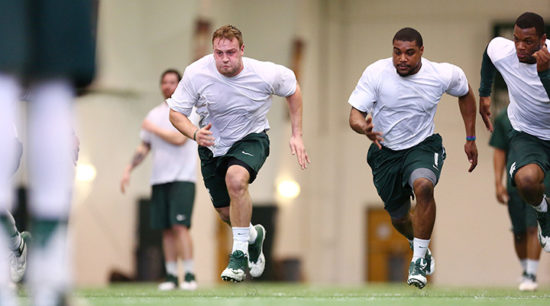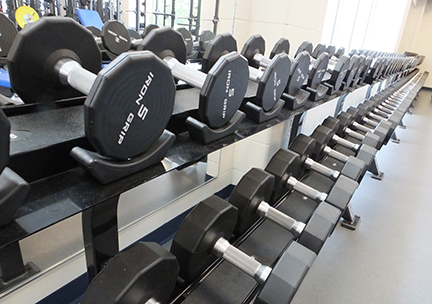New Year’s resolutions for your strength program

January usually ushers-in the beginning of the offseason strength and conditioning program for a host of sports. Preparation for this crucial period forces coaches to evaluate what they’ve done in the past, discuss implementing some new ideas they learned along the way, and it encourages them to pay attention to detail regarding proper execution and safety.
Since we are facing the offseason head-on, I thought it would be advantageous and meaningful to offer some advice on aspects of the program that I believe are critical to both player safety and development.1. Maintain a year-round, consistent, documented head and neck strengthening program.
I’ve covered this topic in great detail in several Powerline columns over the past 14 years, and its importance cannot be overstated. There are more than 20 pairs of muscles in the head and neck region (not counting those of the facial area), all of which require a strict and constant training emphasis. Doing this serves at least two purpose: Provides a degree of protection to the cervical spine, and constructs a sturdy ballast for the head — a process that medical experts tell us can assist in concussion prevention.
In layman’s terms, a concussion can be incurred when the brain is violently and abruptly jarred inside of the skull. Neurons are twisted and stretched, with subsequent chemical reactions that can inhibit the normal functioning and capacity of the brain’s vital processes.
Cara Troutman-Enseki, co-coordinator of exertion training at the UPMC Center for Sports Medicine in Pittsburgh, who works solely with concussion patients, said, “It doesn’t necessarily have to be a hit to the head; it’s the shaking and concurrent movement of the brain inside the skull. And that’s where neck strength comes into play; it’s going to limit the forces that cause this shaking.”
That’s sound advice from a medical professional who is in the trenches with the concussion issue — a message that should be heeded by coaches of all sports where collisions are inevitable.
2. Maintain educational efforts on the dangers of performance enhancing drugs (PEDs).
According to a 2013 survey conducted by the Professional Baseball Athletic Trainers Society, National Baseball Hall of Fame and the Taylor Hooten Foundation, most people do not view anabolic steroid abuse as a major problem among adolescents. It found that just one of five Americans think that steroid abuse is a real threat in grades nine through 12. One out of two people view it as an issue among college students, and two of three believe that it is mostly a professional league problem, according to The American Public’s Perception of Illegal Steroid Use: A National Survey (2013).
 However, the constituents who designed the survey — in conjunction with the University of Massachusetts Boston — are adamant in their proclamation that about 75 percent of the steroid abusers in this country are teenagers. They add that the problem is “going largely unnoticed.”
However, the constituents who designed the survey — in conjunction with the University of Massachusetts Boston — are adamant in their proclamation that about 75 percent of the steroid abusers in this country are teenagers. They add that the problem is “going largely unnoticed.”
The onus for addressing this issue has been placed on those in my profession of strength and conditioning, as well as all coaches, administrators and educators at every level. We are the ones who must be the tip of the spear in mentoring, educational efforts and relentless public denouncement of these perilous substances. The regrettable reality is that androgenic-anabolic steroid abuse — including the entire family of their precursors and designer compounds — are here to stay. And, contrary to the erroneous and misguided proclamations of abusers and unscrupulous distributors, they cannot be absorbed into the body for any indefinite period of time without negative health consequences. Some of these ill effects can be devastating.
Our duty is clearly defined: We are obligated to take off the gloves, fight this menace with our bare knuckles, and enable our student-athletes to compete and grow on the common grounds of good health and great integrity.
3. Overload without overtraining.
The overload principle is one of the true staples in strength and conditioning. While there are numerous methods for implementing it, it basically calls for increased intensity, duration or workload volume over a designated time frame. The scientific literature tells us that overloading the neuromuscular system via strength training, running and skill-specific tasks is necessary to push through homeostasis (i.e. the state of normalcy or equilibrium) to improve performance capacity. Supercompensation, a term that simply refers to working hard and then enabling the body to recover and return even stronger, is a process that is crucial for optimal athletic performance.
The caveat to this axiom is that too much hard training without the proper recovery strategies can actually lead to diminishing returns and poor performance. That can result in Overtraining Syndrome (OTS), which is a physical and psychological state of overwhelming fatigue and noticeable fall-off in focus, execution, retention and skill efficiency.
Here are a few suggestions for avoiding OTS:
- Control training intensity by carefully inserting lower-intensity days after two consecutive moderate to high intensity sessions.
- Properly placed off-days are crucial to recovery. A minimum of two and sometimes three days completely removed from training each week during the offseason enhances recovery capabilities and allows the body to respond to training in a positive manner.
- Paying attention to daily sleep and nutritional habits are just as important as any training variable. Too many athletes are trying to get by on five or six hours of sleep per night, when seven or eight hours are minimal for optimal recovery. Sound nutrition keeps athletes in the state of positive calorie balance, with energy in full supply, and structural tissues repaired from the microtrauma induced by training activities.
 At the very least, this includes paying attention to restoring muscle glycogen with carbohydrates, along with a quality protein source, electrolyte replenishment and plenty of fluid within an hour of completing a training session. For most athletes, ingesting 75 grams of carbohydrate and 20 grams of protein during that 30- to 60-minute post-workout window is a good start.
At the very least, this includes paying attention to restoring muscle glycogen with carbohydrates, along with a quality protein source, electrolyte replenishment and plenty of fluid within an hour of completing a training session. For most athletes, ingesting 75 grams of carbohydrate and 20 grams of protein during that 30- to 60-minute post-workout window is a good start.
4. Incorporate unilateral movements liberally.
A viable, easily administered approach to ameliorating neuromuscular deficits and imbalances — in addition to providing myriad rehabilitation options — is unilateral strength training. Dumbbells (DBs), kettlebells, other low-mass implements and a host of machines with unilateral accommodations can and should be a part of every strength training schematic.
Providing an independent stimulus to both the upper and lower extremities and their adjacent musculature can pay huge dividends in addressing the aforementioned issues. Unilateral training forces each limb to take on the brunt of the load, without the contralateral limb compromising the stimulus, especially when it is the dominant limb.
5. Refurbish the learning curve.
Today’s high-tech world has certainly infiltrated athletics, and it has proved to be a double-edged sword. On the upside, we have new designs in protective equipment; devices equipped with the software to track, document, record and communicate just about everything we do; and new and improved training equipment that seems to surface on a monthly basis. The underbelly of the beast includes, as we have discussed, the scourge of PEDs, designer steroid compounds and the proliferation of questionable over-the-counter supplements — some of which are contaminated with PED residues.
As coaches, it’s our responsibility to provide student-athletes and our entire athletic departments with the best possible information on the vast array of immediate and peripheral components that can have both positive and negative effects on our programs. Whenever possible, coaching staffs must partake in continuing education activities that supersede the Xs and Os of their specific sports and include an emphasis on sports nutrition, strength and conditioning, PED abuse, collegiate admission standards and the burgeoning area of technical support. And, without question, instruction and certification in CPR, automated external defibrillators and First Aid are paramount.
To contact Ken Mannie about this topic or anything else you’ve read in Powerline, send him an email at [email protected].


